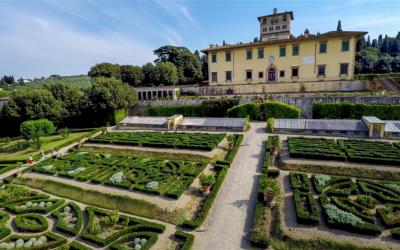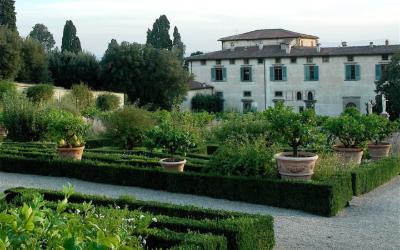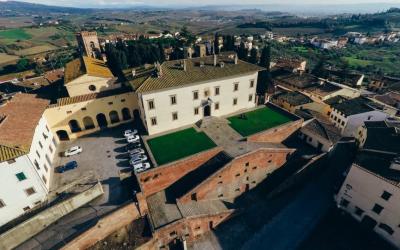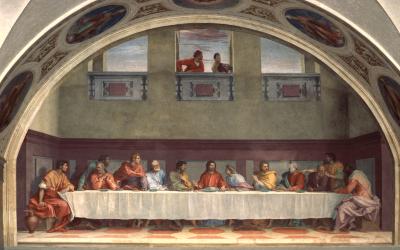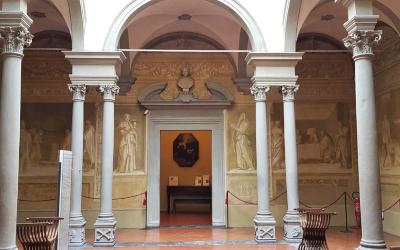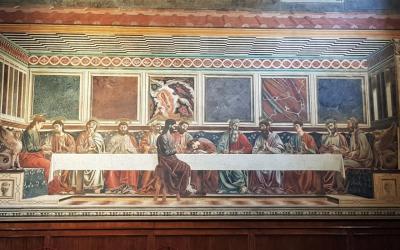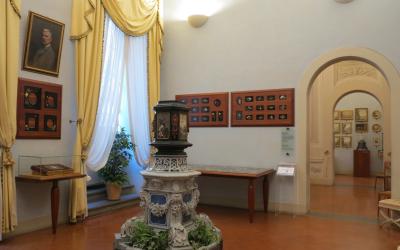The Villa stands out for its unmistakable tower, in a dominant position on the slopes of Monte Morello.
Declared a UNESCO World Heritage Site in 2013, this villa, located just a few kilometres from Florence, is the quintessential suburban retreat—a refuge for the Grand Dukes of the Medici family from the demands of city life.
-
Opening days
Tuesday to Sunday
-
Opening times
April to September
-
Garden: Tuesday - Sunday, 8:30 a.m. – 6:30 p.m. (last admission 5:30 p.m.)
-
Villa: Tuesday - Sunday, admission is by escorted visit only at the following times: 9:30 a.m., 10:30 a.m., 11:30 a.m., 12:30 p.m., 2:00 p.m., 3:00 p.m., 4:00 p.m., and 5:00 p.m. (for a maximum of 25 people per visit).
On June 24th
On June 24th, the Villa and Park will be open during the following hours:
-
Garden: Tuesday - Sunday, 8:30 a.m. – 6:30 p.m. (last admission 5:30 p.m.)
-
Villa: Tuesday - Sunday, admission is by escorted visit only at the following times: 9:30 a.m., 10:30 a.m., 11:30 a.m., 12:30 p.m., 2:00 p.m., 3:00 p.m., 4:00 p.m., and 5:00 p.m. (for a maximum of 25 people per visit).
November to February
-
Garden: Tuesday - Sunday, 8:30 a.m. – 4:30 p.m. (last admission 3:30 p.m.)
-
Villa: Tuesday - Sunday, admission is by escorted visit only at the following times: 9:30 a.m., 10:30 a.m., 11:30 a.m., 12:30 p.m., 2:00 p.m., and 3:00 p.m. (for a maximum of 25 people per visit).
October and March
-
Garden and Park: Tuesday - Sunday, 8:30 a.m. – 5:30 p.m. (last admission 4:30 p.m.)
-
Villa: Tuesday - Sunday, admission is by escorted visit only at the following times: 9:30 a.m., 10:30 a.m., 11:30 a.m., 12:30 p.m., 2:00 p.m., 3:00 p.m., and 4:00 p.m. (for a maximum of 25 people per visit).
-
-
Closing
Mondays, January 1st, December 25th.
-
Extra Opening times
December 14, 2025,
Special opening hours until 9:00 PM - Web The Medici Villa of La Petraia
-
Feature List
- Info line
-
Accessibility
The Villa, with its unmistakable tower, stands in a dominant position on the slopes of Monte Morello, descending towards the plain with a splendid view over Florence. The south side overlooks the formal garden, which is arranged on three terraced levels that take advantage of the site's natural slope: the parterre level, the nursery level, and the "figurine" level. Despite modifications, particularly in the 18th and 19th centuries, the garden still retains the geometric spatiality of the original 16th-century design commissioned by Ferdinando I de' Medici. This original layout is depicted in the lunette by Giusto Utens, which is preserved in the villa along with the other thirteen in the series. To the north, a romantic-style park, created in the 19th century at the behest of Leopold II of Lorraine, extends for several hectares.
A BRIEF HISTORY
Shortly before the mid-16th century, the villa and its lands became the property of Cosimo I, who initiated the first modernization works. It was later inherited by his son and successor to the Grand Duchy, Ferdinando I (following the death of his brother Francesco), who undertook a complete renovation. He transformed the pre-existing medieval building, likely a turreted castle, into what would become the model for the Tuscan country villa. The courtyard, which has always been the heart of the building, was created on the ground floor with the west and east loggias above it. It was frescoed with two magnificent cycles: one from the 16th century, attributable to Cosimo Daddi, depicting scenes from the Deeds of Godfrey of Bouillon (an ancestor of Ferdinando's consort, Christina of Lorraine), and another commissioned by Prince Don Lorenzo, son of Christina and Ferdinando, dating to the second quarter of the 17th century. This latter cycle, created by Baldassarre Franceschini, known as il Volterrano, portrays the Splendors of the Medici. During the Savoy era, on the occasion of the engagement celebration for the King's son, Emanuele di Mirafiori, to Blanche de Larderel, the courtyard was transformed into a ballroom by covering it with a glass and iron roof and enclosing the loggias, which have since been reopened.
In the 18th century, with the extinction of the Medici dynasty, the Villa passed to the House of Lorraine, the new Grand Dukes. With the Unification of Italy, La Petraia became one of the favourite residences of King Victor Emmanuel II and Rosa Vercellana, the "bella Rosina," the King's morganatic wife. This period saw several transformations that affected both the interior design and the garden, largely shaping its current appearance. In addition to the aforementioned conversion of the courtyard into a ballroom with its skylight, from which a grand amethyst-coloured glass chandelier hangs, the apartments on the ground and first floors were rearranged to accommodate the new sovereign and the Countess of Mirafiori. These rooms feature furnishings and tapestries from the royal palaces of the pre-unification states, which became part of the Crown's endowment. The so-called "Piano della figurina" (Figurine Level) of the garden—the level adjacent to the east side of the villa—was also redesigned. It takes its name from the bronze sculpture of Venus-Fiorenza, a masterpiece by Giambologna, which crowns the fountain. The statue was moved here from the garden of the Villa di Castello in 1788, during the time of Peter Leopold of Lorraine, and is now preserved in a room inside the villa. The Savoy redesign plan, drafted in 1872 by Ferdinando Lasinio, included the creation of two large elliptical aviaries and other cages for rare birds (no longer on site), as well as the delightful Belvedere on the southern corner of the garden to the right of the villa, which can still be admired today.
Services
-
Visits
Guided Tours of the Villa:
available in Italian
Tuesday - Sunday: Guided tours for up to 25 people,
at 9:30 a.m., 10:30 a.m., 11:30 a.m., 12:30 p.m., 2:00 p.m., 3:00 p.m., and 4:00 p.m.
Where
via della Petraia, 40 - 50141 Firenze (FI)
Visiting Rules
Weather Alerts: In the event of a yellow, orange, or red weather alert, the parks, gardens, and outdoor areas of the Tuscany Regional Museums Directorate may be closed to the public to ensure safety.
Temporary Park Closure: Please be advised that the park is temporarily closed to the public for safety maintenance. The garden, however, will remain open as usual
Access is forbidden to dogs and any other pets, regardless of breed or size, even if on a leash and/or wearing a muzzle.

